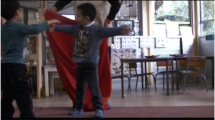Abstract
In 1991, David Macaulay was awarded the Randolph Caldecott Medal for his picturebook, Black and White (1990). He believed the Caldecott committee’s choice communicated many messages to readers of all ages: “that it is essential to see, not merely to look; that words and pictures can support each other; that it isn’t necessary to think in a straight line to make sense; and finally that risk can be rewarded” (p. 419). This article focuses on how Macaulay uses play to engage readers—to arouse their curiosity, to make them think, and to incite them to ‘see things’ in Black and White. Excerpts from Grade 5 students’ written responses illustrate some of their responses to and interpretations of various kinds of narrative and illustrative play in Black and White.

Similar content being viewed by others
References
Allen, G. (2000) Intertextuality. New York: Routledge.
Anstey, M. (2002) It’s not all black and white’: Postmodern picture books and new literacies, Journal of Adolescent and Adult Literacy, 45(6), 444–457.
Bader, B. (1976) American picturebooks from Noah’s ark to The beast within. New York: Macmillan.
Barthes, R. (1975) The pleasure of the text. London: Jonathan Cape.
Bateson, G. (1972) Steps to an ecology of mind: Collected essays in anthropology, sychiatry, evolution, and epistemology. San Francisco: Chandler Publications.
Coles, M., & Hall, C. (2001) Breaking the line: New literacies, postmodernism and the teaching of printed texts, Reading: Literacy and Language, 35(3), 111–114.
Collins, L. (2002) The virtue of ‘stubborn curiosity’: Moral literacy in Black and White, The Lion and the Unicorn, 26(1), 31–49.
Cuddon, J. A. (1999) The Penguin dictionary of literary terms and literary theory (4th ed.). New York: Penguin Books.
Dresang, E. (1999) Radical change: Books for youth in a digital age. New York: The H. W. Wilson Company.
Dresang, E., & McClelland, K. (1995) Black and white: A journey, Horn Book Magazine, 71(6), 704–710.
Goldstone, B. (1998) Ordering the chaos: Teaching metafictive characteristics of children’s books, Journal of Children’s Literature, 24(2), 48–55.
Goldstone, B. (2001/2002) Whaz up with our books? Changing picture book codes and teaching implications, The Reading Teacher, 55(4), 362–370.
Hans, J. S. (1981) The play of the world. Amherst, MA: University of Massachusetts Press.
Hassan, I. (1997) Toward a concept of postmodernism, In Waugh, P. (Ed.), Revolutions of the word: Intellectual contexts for the study of modern literature. New York: Arnold, pp. 95–101.
Holquist, M. (1990) Dialogism: Bakhtin and his world. New York: Routledge.
Kaplan, D. (2003) Read all over: Postmodern resolution in Macaulay’s Black and White, Children’s Literature Association Quarterly, 28(1), 37–41.
Kress, G. (2003) Literacy in the new media age. London: Routledge.
Lewis, D. (1996) Going along with Mr. Gumpy: Polysystemy & play in the modern picture book, Signal: Approaches to Children’s Books, 27(80), 105–119.
Lewis, D. (2001) Reading contemporary picturebooks: Picturing text. New York: RoutledgeFalmer.
Macaulay, D. (1987) Why the chicken crossed the road. Boston, MA: Houghton Mifflin.
Macaulay, D. (1990) Black and white. Boston: Houghton Mifflin Company.
Macaulay, D. (1991) Caldecott acceptance speech. The Horn Book Magazine, 68(July–August), 410–421.
Macaulay, D. (1995) Shortcut. Boston, MA: Houghton Mifflin.
McCallum, R. (1996) Metafictions and experimental work, In Hunt, P. (Ed.), International companion encyclopedia of children’s literature. New York: Routledge, pp. 397–409.
McClay, J. (2000) Wait a second...: Negotiating complex narratives in Black and White, Children’s Literature in Education, 31(2), 91–106.
Meek, M. (1988) How texts teach what readers learn. Stroud, Glos: The Thimble Press.
Millar, S. (1968) The psychology of play. Great Britain: Penguin.
Orr, L. (1991) A dictionary of critical theory. New York: Greenwood Press.
Pantaleo, S. (2003) Godzilla lives in New York: Grade 1 students and the peritextual features of picture books, Journal of Children’s Literature, 29(2), 66–77.
Pantaleo, S. (2004) The long, long way: Young children explore the fabula and syuzhet of Shortcut, Children’s Literature in Education: An International Quarterly, 35(1), 1–20.
Piaget, J. (1951) Play, dreams and imitation in childhood. London: Routledge and Kegan Paul Ltd.
Rodari, G. (1996) The grammar of fantasy: An introduction to the art of inventing stories. (J. Zipes, Trans.) New York: Teachers & Writers Collaborative.
Roukes, N. (1997) Humor in art: A celebration of visual wit. Worcester, MA: Davis Publications, Inc.
Stephens, J., & Watson, K. (1994) From picture book to literary theory. Sydney, AU: St. Clair Press.
Stevenson, D. (1994) If you read this last sentence, it won’t tell you anything: Postmodernism, self-referentiality, and The Stinky Cheese Man, Children’s Literature Association Quarterly, 19(1), 32–34.
Sutherland-Smith, W. (2002) Weaving the literacy web: Changes in reading from page to screen, The Reading Teacher, 55(7), 662–669.
Trites, R. S. (1994) Manifold narratives: Metafiction and ideology in picture books Children’s Literature in Education, 25(4), 225–242.
Vygotsky, L. (1962) Thought and language. Cambridge, MA: MIT Press.
Waugh, P. (1984) Metafiction: The theory and practice of self-conscious fiction. New York: Methuen.
Yearwood, S. (2002) Popular postmodernism for young adult readers: Walk Two Moons, Holes and Monster, The ALAN Review, 29(3), 50–53.
Author information
Authors and Affiliations
Corresponding author
Additional information
Illustrations from BLACK AND WHITE by David Macaulay. Copright © 1990 by David Macaulay. Reprinted by permission of Houghton Mifflin Company. All rights reserved.
Sylvia Pantaleo is an Associate Professor in the Department of Curriculum and Instruction in the Faculty of Education at the University of Victoria, British Columbia, Canada. She teaches undergraduate and graduate courses in children’s literature and all areas of the language arts.
Rights and permissions
About this article
Cite this article
Pantaleo, S.J. “Everything Comes from Seeing Things”: Narrative and Illustrative Play in Black and White . Child Lit Educ 38, 45–58 (2007). https://doi.org/10.1007/s10583-006-9029-x
Published:
Issue Date:
DOI: https://doi.org/10.1007/s10583-006-9029-x




